Design, Analysis, and Verification of a Decoupled Dual-Output Wireless Power Transfer System with a Constant Voltage Output and a Constant Current Output
Abstract
:1. Introduction
2. Theoretical Analysis of Magnetic Coupler
3. Theoretical Analysis of the Proposed Dual-Output WPT System
4. Parameter Design and Simulation Verification
4.1. Parameter Design of the Proposed WPT System
4.2. Simulation Experiment Verification of the Proposed Dual-Output WPT System
5. Experimental Verification
5.1. Magnetic Coupler Size Design
5.2. Experimental Prototype
5.3. Experimental Results
6. Conclusions
Author Contributions
Funding
Institutional Review Board Statement
Informed Consent Statement
Data Availability Statement
Conflicts of Interest
References
- Wang, Q.; Li, Z.; Yang, B.; Lu, Y.; Mai, R.; He, Z.; Chen, Y. Inductive Power Transfer System with Constant Current-Constant Voltage Charging Tolerating Misalignment Based on Multi-Objective Optimization for Compensation Topology. IEEE Trans. Power Electron. 2025, 40, 4581–4591. [Google Scholar] [CrossRef]
- Jia, Y.; Zhao, L.; Wang, Z.; Tang, C.; Chen, F.; Feng, H. Integrated LCC-LCC Topology for WPT System with CC Output Regarding Air Gap and Load Variations. IEEE Trans. Power Electron. 2024, 39, 11904–11915. [Google Scholar] [CrossRef]
- Lillholm, M.-B.; Dou, Y.; Chen, X.; Zhang, Z. Analysis and Design of 10-MHz Capacitive Power Transfer with Multiple Independent Outputs for Low-Power Portable Devices. IEEE J. Emerg. Sel. Top. Power Electron. 2022, 10, 149–159. [Google Scholar] [CrossRef]
- Chen, Y.; Yang, N.; Li, Q.; He, Z.; Mai, R. New parameter tuning method for LCC/LCC compensated IPT system with constant voltage output based on LC resonance principles. IET Power Electron. 2019, 12, 2466–2474. [Google Scholar] [CrossRef]
- Diekhans, T.; De, D. A dual-side controlled inductive power transfer system optimized for large coupling factor variations and partial load. IEEE Trans. Power Electron. 2015, 30, 6320–6328. [Google Scholar] [CrossRef]
- Wang, S.; Liu, Y.; Wang, X. Resonant Converter for Battery Charging Applications with CC/CV Output Profiles. IEEE Access 2020, 8, 54879–54886. [Google Scholar] [CrossRef]
- Qu, X.; Zhang, W.; Wong, S.-C.; Tse, C.-K. Design of a Current-Source-Output Inductive Power Transfer LED Lighting System. IEEE Trans. Instrum. Meas. 2015, 3, 306–314. [Google Scholar]
- Li, Y.; Hu, J.; Li, X.; Wang, H.; Cheng, K.W.E. Cost-effective and compact multistring LED driver based on a three-coil wireless power transfer system. IEEE Trans. Power Electron. 2019, 34, 7156–7160. [Google Scholar] [CrossRef]
- Li, Y.; Hu, J.; Li, X.; Chen, F.; Xu, Q.; Mai, R.; He, Z. Analysis, Design, and Experimental Verification of a Mixed High-Order Compensations-Based WPT System with Constant Current Outputs for Driving Multistring LEDs. IEEE Trans. Ind. Electron. 2020, 67, 203–213. [Google Scholar] [CrossRef]
- Arnitz, D.; Reynolds, M. MIMO wireless power transfer for mobile devices. IEEE Pervasive Comput. 2016, 15, 36–44. [Google Scholar] [CrossRef]
- Mai, R.; Li, H.; Liu, Y.; Zhou, K.; Fu, L.; He, Z. A Three-Phase Dynamic Wireless Charging System with Constant Output Voltage. Energies 2018, 11, 45. [Google Scholar] [CrossRef]
- Jonah, O.; Georgakopoulos, S.; Tentzeris, M.M. Orientation insensitive power transfer by magnetic resonance for mobile devices. In Proceedings of the 2013 IEEE Wireless Power Transfer (WPT), Perugia, Italy, 15–16 May 2013; pp. 5–8. [Google Scholar]
- Hossain, A.; Darvish, P.; Mekhilef, S.; Tey, K.S.; Tong, C.W. A new coil structure of dual transmitters and dual receivers with integrated decoupling coils for increasing power transfer and misalignment tolerance of wireless EV charging system. IEEE Trans. Ind. Electron. 2021, 69, 7869–7878. [Google Scholar] [CrossRef]
- Wang, H.; Cheng, K. Analysis, design, and validation of a decoupled double-receiver wireless power transfer system with constant voltage outputs for industrial power supplies. IEEE Trans. Ind. Inform. 2022, 19, 362–370. [Google Scholar] [CrossRef]
- Wang, X.; Leng, M.; Zhang, X.; Tian, Q.; Zhou, X.; Guo, B.; Ma, H. Multioutput Wireless Charger for Drone Swarms with Reduced Switch Requirements and Independent Regulation Capability. IEEE Trans. Ind. Electron. 2024, 71, 4883–4895. [Google Scholar] [CrossRef]
- Casanova, J.; Low, Z.; Lin, J. A Loosely Coupled Planar Wireless Power System for Multiple Receivers. IEEE Trans. Ind. Electron. 2009, 56, 3060–3068. [Google Scholar] [CrossRef]
- Song, K.; Yang, G.; Guo, Y.; Lan, Y.; Dong, S.; Jiang, J. Design of DD Coil with High Misalignment Tolerance and Low EMF Emissions for Wireless Electric Vehicle Charging Systems. IEEE Trans. Power Electron. 2020, 35, 9034–9045. [Google Scholar] [CrossRef]
- Campi, T.; Cruciani, S.; Feliziani, M. Magnetic shielding of wireless power transfer systems. In Proceedings of the 2014 International Symposium on Electromagnetic Compatibility, Tokyo, Japan, 12–16 May 2014; pp. 422–425. [Google Scholar]
- Mai, R.; Luo, Y.; Yang, B.; Song, Y.; Liu, S.; He, Z. Decoupling Circuit for Automated Guided Vehicles IPT Charging Systems with Dual Receivers. IEEE Trans. Power Electron. 2020, 35, 6652–6657. [Google Scholar] [CrossRef]
- Wang, X.; Xu, J.; Ma, H.; Zhang, Y. A Reconstructed S-LCC Topology with Dual-Type Outputs for Inductive Power Transfer Systems. IEEE Trans. Power Electron. 2020, 35, 12606–12611. [Google Scholar] [CrossRef]
- Zhong, W.; Hui, S.Y.R. Auxiliary Circuits for Power Flow Control in Multifrequency Wireless Power Transfer Systems with Multiple Receivers. IEEE Trans. Power Electron. 2014, 30, 5902–5910. [Google Scholar] [CrossRef]
- Gong, Y.; Zhang, Z.; Chang, S. Single-Transmitter-Controlled Multiple-Channel Constant Current Outputs for In-Flight Wireless Charging of Drones. IEEE Trans. Ind. Electron. 2024, 71, 3606–3616. [Google Scholar] [CrossRef]
- Qi, C.; Huang, S.; Chen, X.; Wang, P. Multifrequency Modulation to Achieve an Individual and Continuous Power Distribution for Simultaneous MR-WPT System with an Inverter. IEEE Trans. Power Electron. 2021, 36, 12440–12455. [Google Scholar] [CrossRef]
- Pratik, U.; Varghese, B.J.; Azad, A.; Pantic, Z. Optimum Design of Decoupled Concentric Coils for Operation in Double-Receiver Wireless Power Transfer Systems. IEEE J. Emerg. Sel. Top. Power Electron. 2019, 7, 1982–1998. [Google Scholar] [CrossRef]
- Yang, L.; Dong, K.; Wang, Y.; Cai, C. Analysis and Design of a Dual-Receiver WPT System with Constant Current and Constant Voltage Dual-Type Outputs. IEEE Trans. Transp. Electrif. 2024, 11, 4060–4069. [Google Scholar] [CrossRef]
- Zhang, Y.; Yan, Z.; Liang, Z.; Li, S.; Mi, C.C. A high-power wireless charging system using LCL-N topology to achieve a compact and low-cost receiver. IEEE Trans. Power Electron. 2019, 35, 131–137. [Google Scholar] [CrossRef]
- Peng, C.; Chen, Z.; Liu, Z.; Wang, J.; Liang, J.; Li, C.; Tao, S.; Li, J. On the Load-Independence of a Multi-Receiver Wireless Power Transfer System. IEEE Microw. Wirel. Components Lett. 2019, 29, 563–565. [Google Scholar] [CrossRef]
- Vu, V.; Tran, D.; Choi, W. Implementation of the constant current and constant voltage charge of inductive power transfer systems with the double-sided LCC compensation topology for electric vehicle battery charge applications. IEEE Trans. Power Electron. 2017, 33, 7398–7410. [Google Scholar] [CrossRef]
- Niu, S.; Yu, H.; Niu, S.; Jian, L. Power loss analysis and thermal assessment on wireless electric vehicle charging technology: The over-temperature risk of ground assembly needs attention. Appl. Energy 2020, 275, 115344. [Google Scholar] [CrossRef]
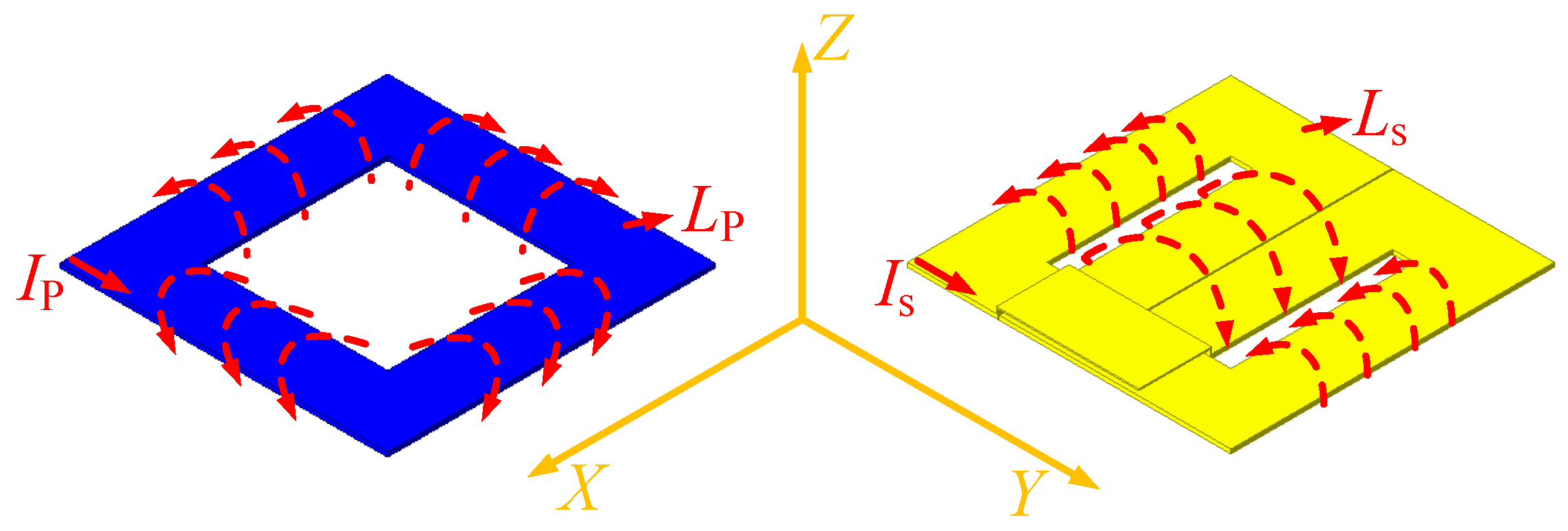
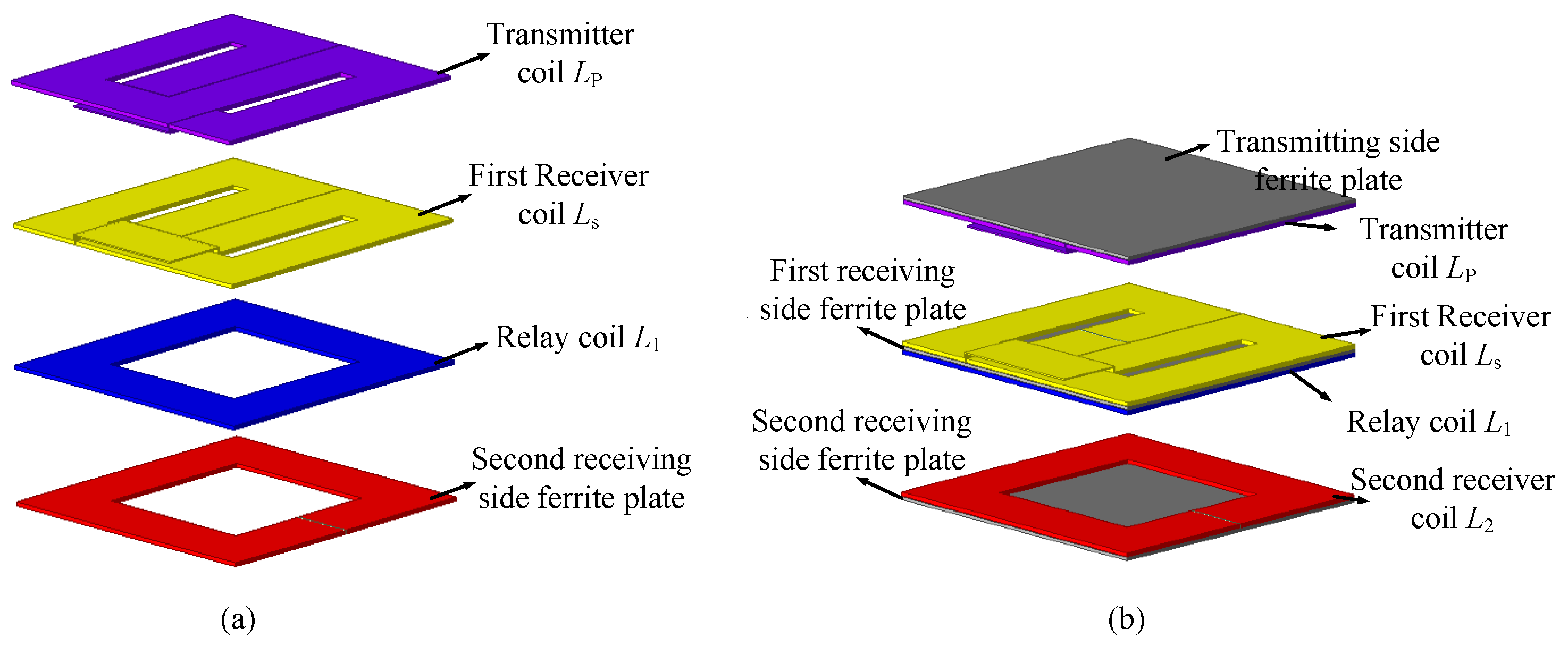

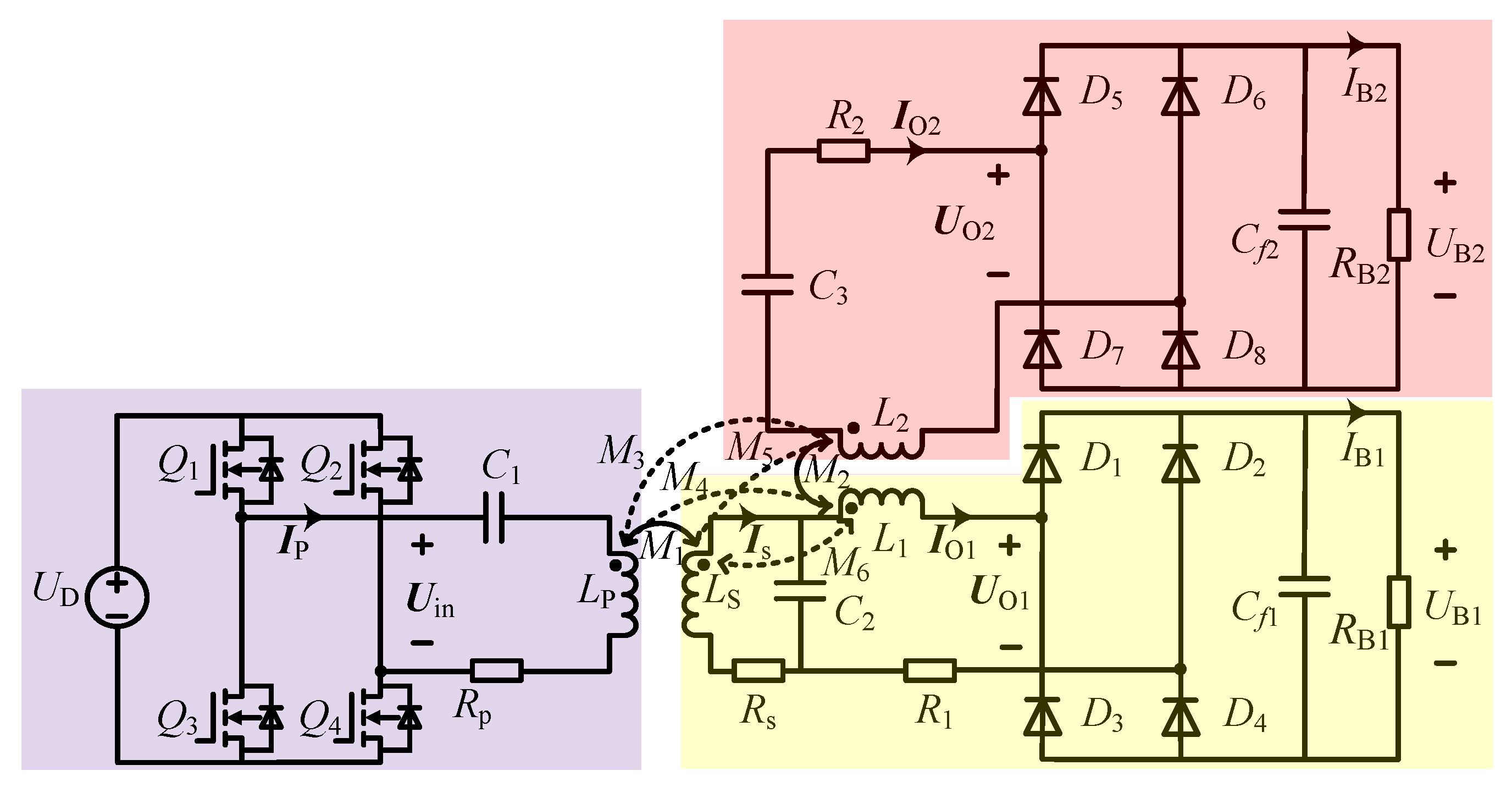

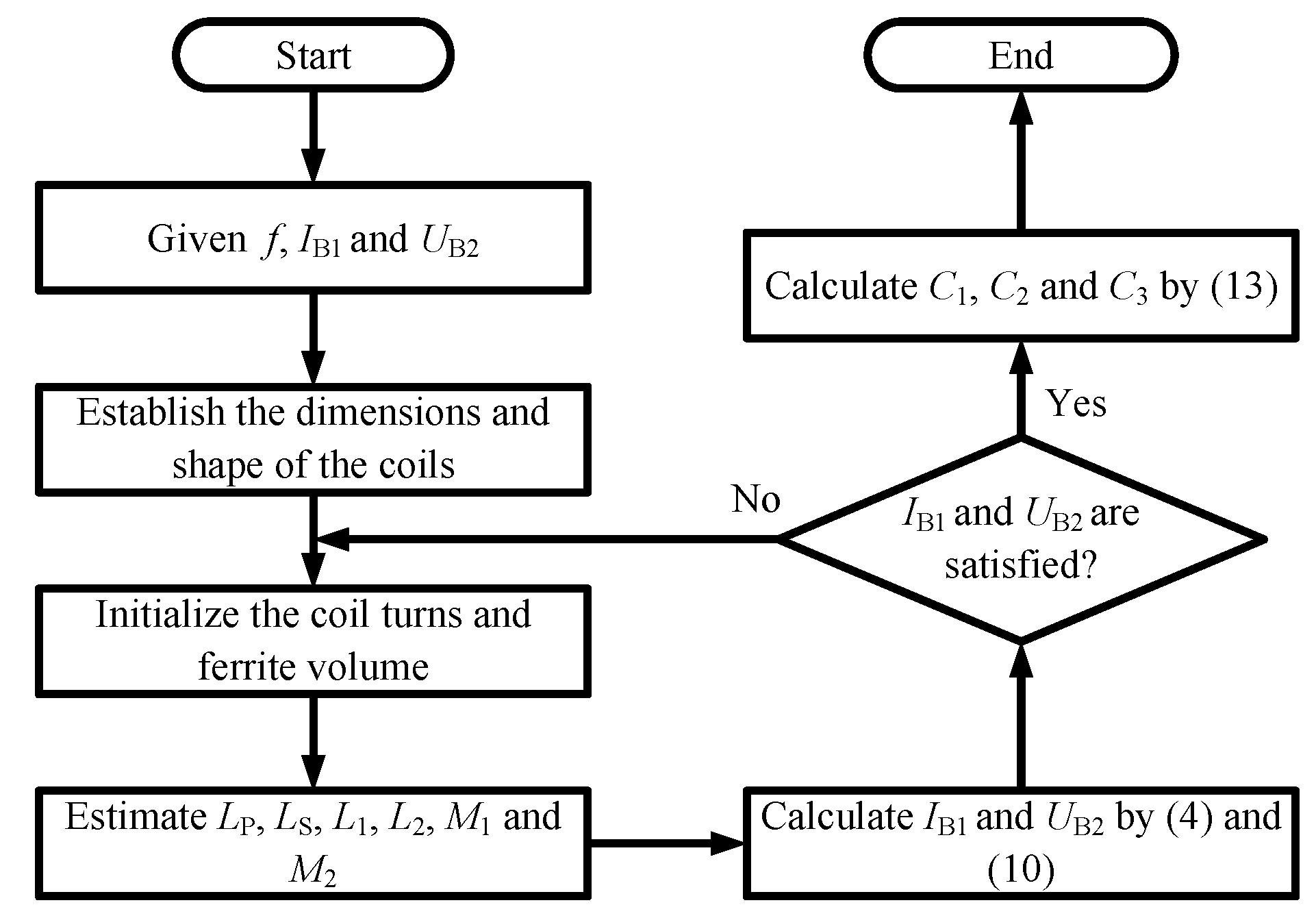

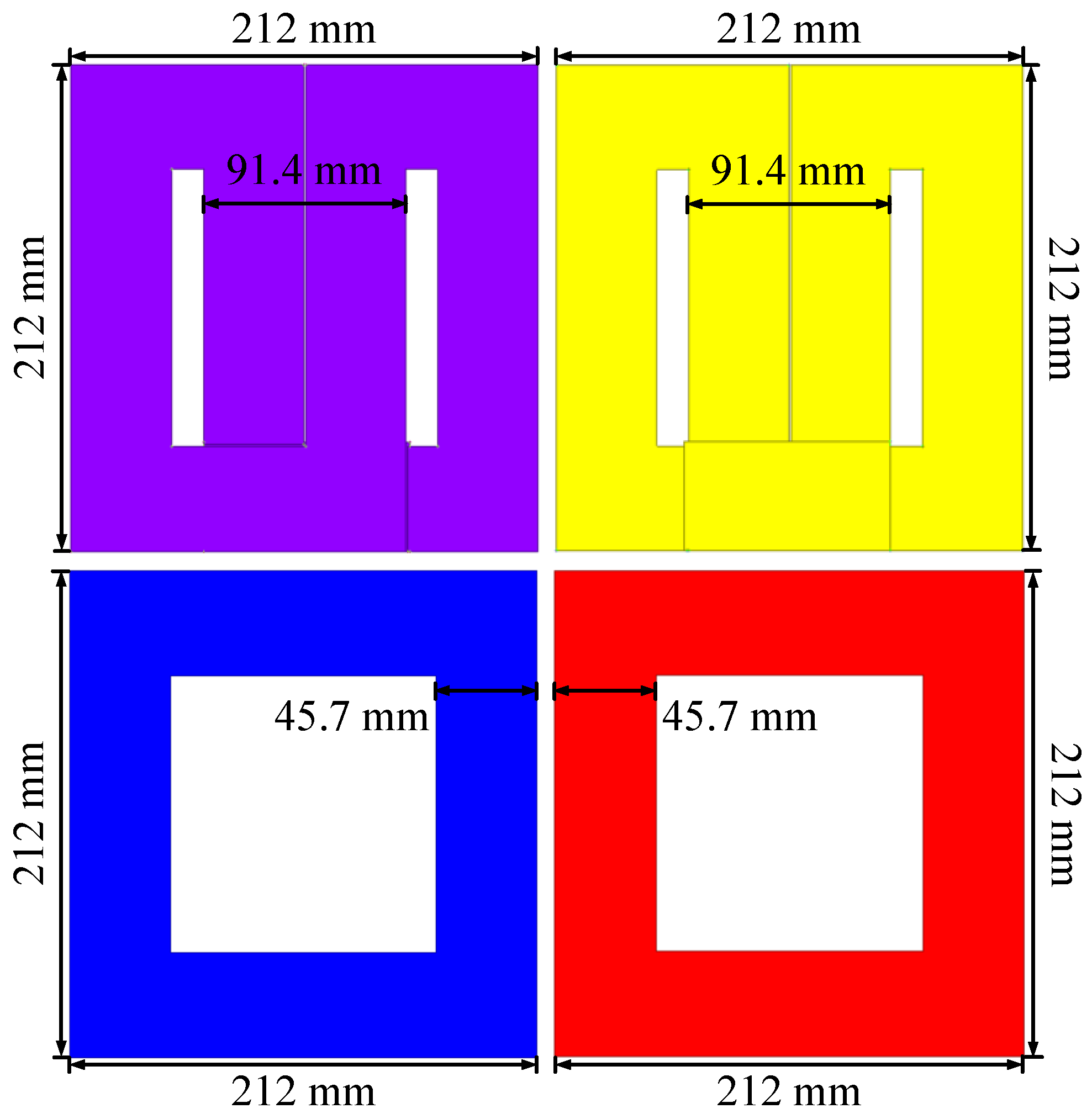


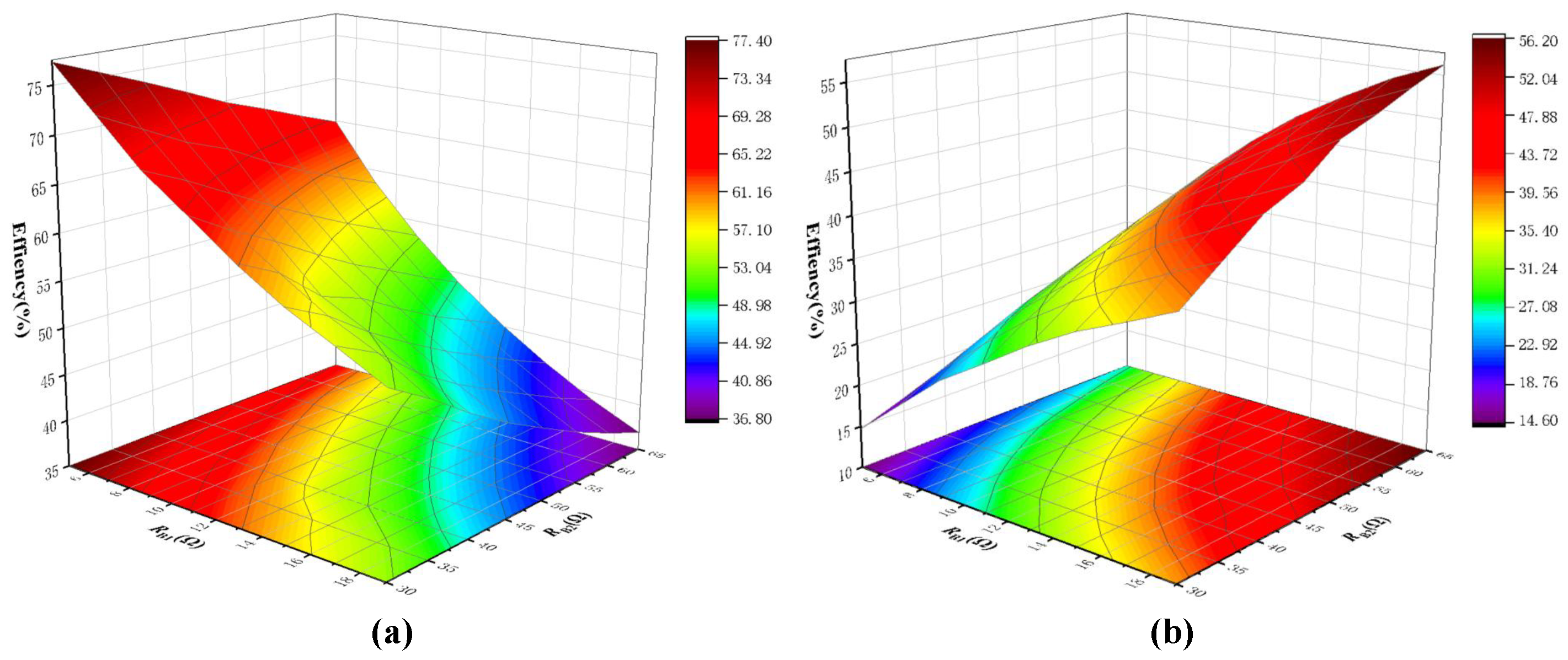


| Parameters | Value | Parameters | Value |
|---|---|---|---|
| f | 85 kHz | E | 60 V |
| 101.93 μH | 48.02 | ||
| 101.32 μH | 72.31 | ||
| 92.97 μH | 37.64 | ||
| 93.15 μH | 39.07 μH | ||
| 44.51 μH | - | - |
| Parameter | Specific Information |
|---|---|
| Litz wire | 400 strands with a diameter of 3.2 mm |
| transmitter DD coil | Size of 212 mm × 212 mm, 14 turns |
| first receiver DD coil | Size of 212 mm × 212 mm, 14 turns |
| relay Q coil | Size of 212 mm × 212 mm, 14 turns |
| second receiver Q coil | Size of 212 mm × 212 mm, 14 turns |
| Air gap | 50 mm |
| transmitting side ferrite plate | Size of 212 mm × 212 mm × 2.5 mm |
| first receiving side ferrite plate | Size of 212 mm × 212 mm × 2.5 mm |
| second receiving ferrite side plate | Size of 212 mm × 212 mm × 2.5 mm |
| Parameters | Value | Parameters | Value |
|---|---|---|---|
| f | 85 kHz | E | 60 V |
| 100.21 μH | 47.33 | ||
| 103.11 μH | 71.25 | ||
| 93.34 μH | 36.58 | ||
| 94.65 μH | 40.22 μH | ||
| 43.79 μH | - | - |
| Proposed in | Ref. [15] | Ref. [19] | Ref. [20] | Ref. [21] | Ref. [22] | Ref. [23] | Ref. [25] | This Work |
|---|---|---|---|---|---|---|---|---|
| Space utilization | Low | Normal | Normal | Normal | Low | Low | High | High |
| Quantity of compensation components at the transmitting side | 2 | 3 | 1 | 2 | 3 | 3 | 3 | 1 |
| Quantity of compensation components at the receiving side | 2 | 3 | 3 | 2 | 6 | 2 | 4 | 3 |
| Complex control | Yes | No | Yes | Yes | Yes | Yes | No | No |
Disclaimer/Publisher’s Note: The statements, opinions and data contained in all publications are solely those of the individual author(s) and contributor(s) and not of MDPI and/or the editor(s). MDPI and/or the editor(s) disclaim responsibility for any injury to people or property resulting from any ideas, methods, instructions or products referred to in the content. |
© 2025 by the authors. Licensee MDPI, Basel, Switzerland. This article is an open access article distributed under the terms and conditions of the Creative Commons Attribution (CC BY) license (https://creativecommons.org/licenses/by/4.0/).
Share and Cite
Yu, L.; Lv, Y.; Zhou, X.; Yang, G.; Cai, C.; Yang, L. Design, Analysis, and Verification of a Decoupled Dual-Output Wireless Power Transfer System with a Constant Voltage Output and a Constant Current Output. Electronics 2025, 14, 1706. https://doi.org/10.3390/electronics14091706
Yu L, Lv Y, Zhou X, Yang G, Cai C, Yang L. Design, Analysis, and Verification of a Decoupled Dual-Output Wireless Power Transfer System with a Constant Voltage Output and a Constant Current Output. Electronics. 2025; 14(9):1706. https://doi.org/10.3390/electronics14091706
Chicago/Turabian StyleYu, Le, You Lv, Xuebin Zhou, Guangyi Yang, Changsong Cai, and Lin Yang. 2025. "Design, Analysis, and Verification of a Decoupled Dual-Output Wireless Power Transfer System with a Constant Voltage Output and a Constant Current Output" Electronics 14, no. 9: 1706. https://doi.org/10.3390/electronics14091706
APA StyleYu, L., Lv, Y., Zhou, X., Yang, G., Cai, C., & Yang, L. (2025). Design, Analysis, and Verification of a Decoupled Dual-Output Wireless Power Transfer System with a Constant Voltage Output and a Constant Current Output. Electronics, 14(9), 1706. https://doi.org/10.3390/electronics14091706






